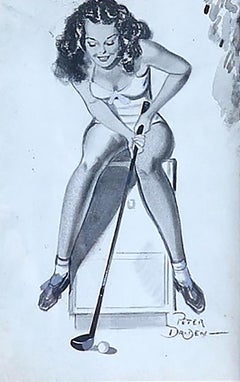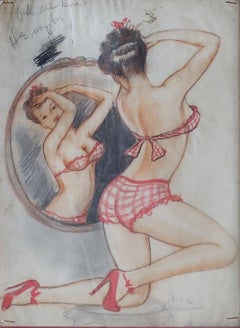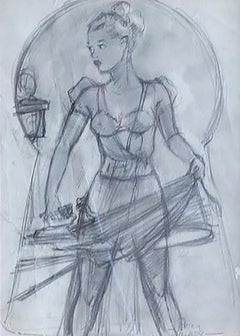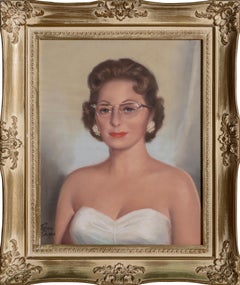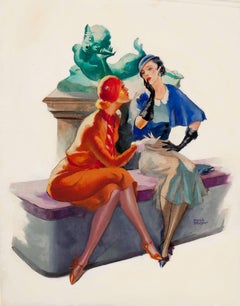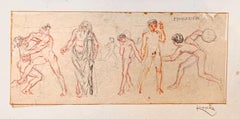Peter Driben Art
to
8
8
6
4
1
1
Girl Playing Golf
By Peter Driben
Located in Fort Washington, PA
Medium: Pen and Ink with White Gouache
Signature: Signed Lower Right
A pin-up study
Category
1940s Peter Driben Art
Materials
Gouache, Pen, Ink
Lady and The Mirror
By Peter Driben
Located in Fort Washington, PA
Medium: Color Pencil on Paper
Signature: Signed Lower Right
A pin-up study.
Category
1940s Peter Driben Art
Materials
Color Pencil, Paper
Pin-Up Study
By Peter Driben
Located in Fort Washington, PA
Medium: Graphite Pencil on Paper
Signature: Signed Lower Right
A pin-up study
Category
1940s Peter Driben Art
Materials
Graphite, Paper
Portrait of a Woman, Framed Pastel Drawing by Peter Driben
By Peter Driben
Located in Long Island City, NY
Peter Driben, best known as an American pin-up artist, was perhaps one of the most productive pin-up artists of the 1940s and 1950s. Driben's pinups delighted the American public from the beginning of World War II until the great baby boom of the 1950s. This portrait of a woman...
Category
Mid-20th Century American Realist Peter Driben Art
Materials
Pastel
Art Deco Pulp cover or pin-up magazine cover
By Peter Driben
Located in Miami, FL
Pulp cover or pin-up magazine cover
signed lower left
some foxing throughout
work is framed
Category
1920s Art Deco Peter Driben Art
Materials
Oil
A Conversation in the Park
By Peter Driben
Located in Fort Washington, PA
Date: 1940s
Medium: Mixed Media on Board
Dimensions: 22.50" x 17.00"
Signature: Signed Lower Right
Category
1940s Peter Driben Art
Materials
Board, Mixed Media
Pin-up, Titter Magazine Cover
By Peter Driben
Located in Fort Washington, PA
Signature: Signed Lower Right
Cover of Titter Magazine
Category
Mid-20th Century Peter Driben Art
Materials
Canvas, Oil
Come with Me!
By Peter Driben
Located in Fort Washington, PA
"Come with Me!" was illustrated by Peter Driben on mixed media on board.
Driben was known for his many pin-up illustrations. He grew up in Boston and studied at the Vaesper Geor...
Category
20th Century Peter Driben Art
Materials
Mixed Media, Board
Related Items
Gymnasium, circa 1908-1909 colored crayon, pencil, gouache and pen and ink
By Frantisek Kupka
Located in Jerusalem, IL
coloured crayon, pencil, gouache and pen and ink on tracing paper mounted onto the artist's mount
The authenticity of this work has been confirmed by Pierre Brullé.
Category
Early 1900s Peter Driben Art
Materials
Ink, Watercolor, Gouache, Laid Paper, Pen
The Abduction of the Sabine Women , a Renaissance drawing by Biagio Pupini
Located in PARIS, FR
This vigorous drawing has long been attributed to Polidoro da Caravaggio: The Abduction of the Sabine Women is one of the scenes that Polidoro depicted between 1525 and 1527 on the façade of the Milesi Palazzo in Rome. However, the proximity to another drawing inspired by this same façade, kept at the Ecole des Beaux-Arts, and to other drawings inspired by Polidoro kept at the Musée du Louvre, leads us to propose an attribution to Biagio Pupini, a Bolognese artist whose life remains barely known, despite the abundant number of drawings attributed to him.
1. Biagio Pupini, a Bolognese artist in the light of the Roman Renaissance
The early life of Biagio Pupini, an important figure of the first half of the Cinquecento in Bologna - Vasari mentions him several times - is still poorly known. Neither his date of birth (probably around 1490-1495) nor his training are known. He is said to have been a pupil of Francesco Francia (1450 - 1517) and his name appears for the first time in 1511 in a contract with the painter Bagnacavallo (c. 1484 - 1542) for the frescoes of a church in Faenza. He then collaborated with Girolamo da Carpi, at San Michele in Bosco and at the villa of Belriguardo.
He must have gone to Rome for the first time with Bagnacavallo between 1511 and 1519. There he discovered the art of Raphael, with whom he might have worked, and that of Polidoro da Caravaggio. This first visit, and those that followed, were the occasion for an intense study of ancient and modern art, as illustrated by his abundant graphic production.
Polidoro da Caravaggio had a particular influence on the technique adopted by Pupini. Executed on coloured paper, his drawings generally combine pen, brown ink and wash with abundant highlights of white gouache, as in the drawing presented here.
2. The Abduction of the Sabine Women
Our drawing is an adaptation of a fresco painted between 1525 and 1527 by Polidoro da Caravaggio on the façade of the Milesi Palace in Rome. These painted façades were very famous from the moment they were painted and inspired many artists during their stay in Rome. These frescoes are now very deteriorated and difficult to see, as the palace is in a rather narrow street.
The episode of the abduction of the Sabine women (which appears in the centre of the photo above) is a historical theme that goes back to the origins of Rome and is recounted both by Titus Livius (Ab Urbe condita I,13), by Ovid (Fasti III, 199-228) and by Plutarch (II, Romulus 14-19). After killing his twin brother Romus, Romulus populates the city of Rome by opening it up to refugees and brigands and finds himself with an excess of men. Because of their reputation, none of the inhabitants of the neighbouring cities want to give them their daughters in marriage. The Romans then decide to invite their Sabine neighbours to a great feast during which they slaughter the Sabines and kidnap their daughters.
The engraving made by Giovanni Battista Gallestruzzi (1618 - 1677) around 1656-1658 gives us a good understanding of the Polidoro fresco, allowing us to see how Biagio Pupini reworked the scene to extract this dynamic group.
With a remarkable economy of means, Biagio Pupini takes over the left-hand side of the fresco and depicts in a very dense space two main groups, each consisting of a Roman and a Sabine, completed by a group of three soldiers in the background (which seems to differ quite significantly from Polidoro's composition).
The balance of the drawing is based on a very strongly structured composition. The drawing is organised around a median vertical axis, which runs along both the elbow of the kidnapped Sabine on the left and the foot of her captor, and the two main diagonals, reinforced by four secondary diagonals. This diamond-shaped structure creates an extremely dynamic space, in which centripetal movements (the legs of the Sabine on the right, the arm of the soldier on the back at the top right) and centrifugal movements (the arm of the kidnapper on the left and the legs of the Sabine he is carrying away, the arm of the Sabine on the right) oppose each other, giving the drawing the appearance of a whirlpool around a central point of support situated slightly to the left of the navel of the kidnapper on the right.
3. Polidoro da Caravaggio, and the decorations of Roman palaces
Polidoro da Caravaggio was a paradoxical artist who entered Raphael's (1483 - 1520) workshop at a very young age, when he oversaw the Lodges in the Vatican. Most of his Roman work, which was the peak of his career, has disappeared, as he specialised in facade painting, and yet these paintings, which are eminently visible in urban spaces, have influenced generations of artists who copied them abundantly during their visits to Rome.
Polidoro Caldara was born in Caravaggio around 1495-1500 (the birthplace of Michelangelo Merisi, known as Caravaggio, who was born there in 1571), some forty kilometres east of Milan. According to Vasari, he arrived as a mason on the Vatican's construction site and joined Raphael's workshop around 1517 (at the age of eighteen according to Vasari). This integration would have allowed Polidoro to work not only on the frescoes of the Lodges, but also on some of the frescoes of the Chambers, as well as on the flat of Cardinal Bibiena in the Vatican.
After Raphael's death in 1520, Polidoro worked first with Perin del Vaga before joining forces with Maturino of Florence (1490 - 1528), whom he had also known in Raphael's workshop. Together they specialised in the painting of palace façades. They were to produce some forty façades decorated with grisaille paintings imitating antique bas-reliefs.
The Sack of Rome in 1527, during which his friend Maturino was killed, led Polidoro to flee first to Naples (where he had already stayed in 1523), then to Messina. It was while he was preparing his return to the peninsula that he was murdered by one of his assistants, Tonno Calabrese, in 1543.
In his Vite, Vasari celebrated Polidoro as the greatest façade decorator of his time, noting that "there is no flat, palace, garden or villa in Rome that does not contain a work by Polidoro". Polidoro's facade decorations, most of which have disappeared as they were displayed in the open air, constitute the most important lost chapter of Roman art of the Cinquecento. The few surviving drawings of the painter can, however, give an idea of the original appearance of his murals and show that he was an artist of remarkable and highly original genius.
4. The façade of the Milesi Palace
Giovanni Antonio Milesi, who commissioned this palace, located not far from the Tiber, north of Piazza Navona, was a native of the Bergamo area, like Polidoro, with whom he maintained close friendly ties. Executed in the last years before the Sack of Rome, around 1526-1527, the decoration of Palazzo Milesi is considered Polidoro's greatest decorative success.
An engraving by Ernesto Maccari made at the end of the nineteenth century allows us to understand the general balance of this façade, which was still well preserved at the time. The frescoes were not entirely monochrome, but alternated elements in chiaroscuro simulating marble bas-reliefs and those in ochre simulating bronze and gold vases...
Category
16th Century Old Masters Peter Driben Art
Materials
Ink, Gouache, Pen
PINKHAS - MIXED MEDIA ON PAPER - UNIQUE PIECE - POETRY - CHAGALL SPIRIT
Located in Tel Aviv - Jaffa, IL
Mixed media on paper
Hand signed
Titled
Unique piece
Category
2010s French School Peter Driben Art
Materials
Acrylic, Gouache, Felt Pen
Free Shipping
H 8.27 in W 8.27 in D 0.04 in
Boissier, Portrait of a Young Man, 1802, Pastel signed and dated
By Boissier
Located in Paris, FR
Boissier (painter and portraitist active at the end of the 18th century)
Portrait of a young man
Signed and dated "Boissier f(ecit) 1802" on the lower right
Pastel on paper transfere...
Category
Early 1800s Old Masters Peter Driben Art
Materials
Pastel
'Bohemian Fantasy', British, 20th Century original painting
Located in Petworth, West Sussex
Circle of Austin Osman Spare (British, 1888 – 1956)
Bohemian Fantasy
Pen and gouache on paper
13.1/2 x 19.5/8 in. (34.3 x 50 cm.)
Category
20th Century Art Nouveau Peter Driben Art
Materials
Gouache, Paper, Pen
H 13.5 in W 19.63 in D 1 in
Male Torso
By John Koch
Located in London, GB
Pencil, coloured pencil and chalk on paper, titled (lower left), signed (lower right), 31cm x 46cm, (51cm x 68cm framed).
John Koch was an American painter and teacher, and an impo...
Category
1950s American Modern Peter Driben Art
Materials
Paper, Chalk, Pencil, Color Pencil
PINKHAS - MIXED MEDIA ON PAPER - UNIQUE PIECE - POETRY - CHAGALL SPIRIT
Located in Tel Aviv - Jaffa, IL
Mixed media on paper
Hand signed
Titled
Unique piece
Category
2010s French School Peter Driben Art
Materials
Acrylic, Gouache, Felt Pen
Free Shipping
H 8.27 in W 8.27 in D 0.04 in
Running Men
Located in London, GB
Graphite and coloured pencil on paper, signed and dated (lower right), 36cm x 44cm, (45cm x 53cm framed). The picture is behind museum quality non-reflective UV glass.
Throughout h...
Category
1990s Contemporary Peter Driben Art
Materials
Paper, Carbon Pencil, Color Pencil
"Jersey Girl" Graphite Drawing
Located in Denver, CO
Tammy Liu-Haller's "Jersey Girl" is an original, handmade charcoal and graphite drawing that depicts a cow in profile.
Category
2010s Photorealist Peter Driben Art
Materials
Archival Paper, Graphite
PINKHAS - MIXED MEDIA ON PAPER - UNIQUE PIECE - POETRY - CHAGALL SPIRIT
Located in Tel Aviv - Jaffa, IL
Mixed media on paper
Hand signed
Titled
Unique piece
Category
2010s French School Peter Driben Art
Materials
Acrylic, Gouache, Felt Pen
Free Shipping
H 8.27 in W 8.27 in D 0.04 in
PINKHAS - MIXED MEDIA ON PAPER - UNIQUE PIECE - POETRY - CHAGALL SPIRIT
Located in Tel Aviv - Jaffa, IL
Mixed media on paper
Hand signed
Titled
Unique piece
Category
2010s French School Peter Driben Art
Materials
Acrylic, Gouache, Felt Pen
Free Shipping
H 8.27 in W 8.27 in D 0.04 in
"Young Woman on Blue Chair" Contemporary Figurative Woman Nude by Shana Wilson
By Shana Wilson
Located in Carmel, CA
Shana Wilson's "Young Woman on Blue Chair" is a 16" x 20" (26.5x30.5 Framed) masterpiece that captures the essence of contentment and relaxation. The young nude woman, with brown hair and a tranquil expression, sits on a light blue chair against a backdrop of a warm, ochre-toned wall. Her posture, leaning to one side with one arm on the armrest and the other resting on her lap, exudes comfort. This framed artwork masterfully portrays a sense of calm and ease, inviting viewers to appreciate the serene moment it portrays. Wilson's attention to detail and use of color create a captivating and emotionally resonant composition.
About the Artist:
Over seven billion souls exist on this planet, each with a unique face and story. Shana transfers her visceral love for the human landscape to canvas, tenderly cradling its peaks and valleys, darkness and light, colors and neutrals, empty and full, hard edges and soft curves. Each brush stroke creates a controlled cacophony as it assembles the intricate jigsaw of the human face. An entire life’s journey is written on this human landscape; a journey that begs to be documented and treasured. Shana’s legacy project is to paint inspirational women from all walks of life, inclusive of all cultures and orientations. The subjects all have one thing in common; the ability to inspire and create social change. She pays tribute to them on canvas, painting a long overdue celebration of trail-blazing women. Visit any major gallery or museum in the world and it is teeming with paintings of nude women...
Category
21st Century and Contemporary Expressionist Peter Driben Art
Materials
Mixed Media, Board
H 16 in W 20 in D 0.75 in
Peter Driben art for sale on 1stDibs.
Find a wide variety of authentic Peter Driben art available for sale on 1stDibs. If you’re browsing the collection of art to introduce a pop of color in a neutral corner of your living room or bedroom, you can find work that includes elements of blue, red and other colors. You can also browse by medium to find art by Peter Driben in paint, board, mixed media and more. Much of the original work by this artist or collective was created during the 20th century and is mostly associated with the Art Deco style. Not every interior allows for large Peter Driben art, so small editions measuring 7 inches across are available. Customers who are interested in this artist might also find the work of Benton Clark, David Fredenthal, and Louis Kronberg. Peter Driben art prices can differ depending upon medium, time period and other attributes. On 1stDibs, the price for these items starts at $1,900 and tops out at $23,500, while the average work can sell for $2,360.
